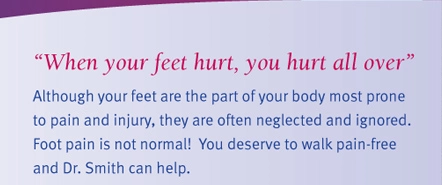Heel Pain
Many people blame heel spurs for heel pain; however, the ligament joining the heel to the ball of the foot, called the plantar fascia, often plays a key role. This thick, fibrous band on the bottom of the foot acts like a bowstring to maintain the arch of the foot. It may be too loose, too tight or swollen for various reasons, from age to injury. Tight tendons, collapsing arches and weight gain are all possible triggers for heel pain.
Preventing Heel Pain
While you can’t stop aging, which may affect the flexibility of your plantar fascia, you can take measures to keep your heels happy. Dr. Smith suggests running on soft, even surfaces, stretching properly, shedding excess pounds and wearing supportive shoes at all times.
To avoid toe nail fungus (as well as athlete’s foot) try this foot care routine:
- Wash & dry your feet thoroughly
- Change socks & footwear regularly when feet perspire
- Wear breathable materials, such as cotton, mesh & leather
- Avoid tight, synthetic shoes & socks
- Always wear shoes — wear flip-flops in communal showers
- Clean bathroom floors, mats and tub surfaces regularly
Treating Heel Pain
While it may take time to resolve heel pain, Dr. Smith states that 95 percent of the symptoms improve with non-surgical treatment in his office. His plans for healthier heels may include:
- Preventive actions, such as stretching, soaking or physical therapy
- Orthotics, such as arch or heel inserts, supportive shoes and night splints
- Medications or injections
These noninvasive options may take 3 to 12 months to have an affect on your symptoms. In rare cases, surgery may be necessary in order to relieve the tension in the plantar fascia.
Heel pain is highly treatable and should be addressed as soon as symptoms appear. Dr. Smith is ready to help with proactive measures to eliminate your foot pain.











